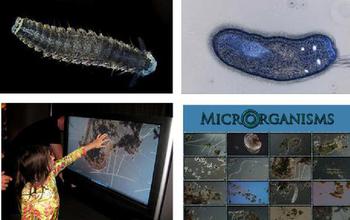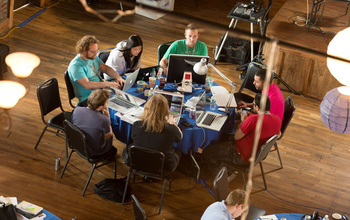All Images
News Release 15-026
From programmable backbones to advanced 'apps': An end-to-end vision of the future Internet
Event brings hundreds of experts together to discuss, demonstrate cutting-edge networking technologies and applications
This material is available primarily for archival purposes. Telephone numbers or other contact information may be out of date; please see current contact information at media contacts.

Illustrations of some of the imagery captured from a Digital Cinema Microscope which has recently been integrated into classroom learning via GENI and US Ignite high-speed networking. At the bottom left, a student interacts with the movie "MicrOrganisms" at an exhibition.
Credit: Richard Weinberg, USC School of Cinematic Arts
Download the high-resolution JPG version of the image. (125.7 KB)
Use your mouse to right-click (Mac users may need to Ctrl-click) the link above and choose the option that will save the file or target to your computer.

A storm surge simulation computed with the ADCIRC (a system of computer programs for solving time dependent, free surface circulation and transport problems in two and three dimensions) storm surge, tide, and wind-wave model on ExoGENI cyberinfrastructure. ExoGeni is a new GENI testbed that links GENI to two advances in virtual infrastructure services outside of GENI: open cloud computing (OpenStack) and dynamic circuit fabrics. The simulation is forced by surface winds and atmospheric pressure from the Weather Research and Forecasting (WRF) model, from a set of ensemble members representing possible evolutions of Hurricane Floyd (1999), which caused substantial storm surge, inundation and rain-related flooding in coastal North Carolina. The WRF winds are shown with the vector field, the simulated water level with the color surface in feet relative to mean sea level, and the ensemble member storm track with the black line. The true Floyd best track is shown in red. The water level reaches about 12 ft along the North Carolina coast, east of Wilmington.
Credit: Brian Blanton, Renaissance Computing Institute, UNC-Chapel Hill
Download the high-resolution JPG version of the image. (98.0 KB)
Use your mouse to right-click (Mac users may need to Ctrl-click) the link above and choose the option that will save the file or target to your computer.

GENI (Global Environment for Network Innovations) provides a virtual laboratory for networking and distributed systems research and education. It is well suited for exploring networks at scale, thereby promoting innovations in network science, security, services and applications.
Credit: GENI Project Office
Download the high-resolution JPEG version of the image. (888.6 KB)
Use your mouse to right-click (Mac users may need to Ctrl-click) the link above and choose the option that will save the file or target to your computer.

Hackanooga 2012, Chattanooga's first-ever hackathon, was held on Sept. 14 and 15, 2012. Presented by U.S. Ignite and Mozilla and sponsored by EPB, Chattanooga Area Chamber of Commerce, the National Science Foundation, CO.LAB, Lamp Post Group and Easy Designs, the 48-hour event connected experienced web developers to Chattanooga's unique one-gigabit-per-second Internet speed. Some 80 hackers hailed across the country and overseas to form teams and leverage the power of the Gig to prototype apps that require high bandwidth or use big data. Potential projects have been identified in areas such as education, clean energy, healthcare and public safety.
Credit: R. Morris / Chattanooga
Download the high-resolution JPG version of the image. (390.0 KB)
Use your mouse to right-click (Mac users may need to Ctrl-click) the link above and choose the option that will save the file or target to your computer.

Children's Mercy Hospital in Kansas City, Mo., is actively exploring and developing new technologies for telemedicine. At the US Ignite application summit in July 2014, the researchers demonstrated new technology for creating heightened virtual healthcare experience using SightDeck for interactive collaboration with video, voice, and graphics.
Credit: SightDeckKC
Download the high-resolution JPG version of the image. (803.4 KB)
Use your mouse to right-click (Mac users may need to Ctrl-click) the link above and choose the option that will save the file or target to your computer.


